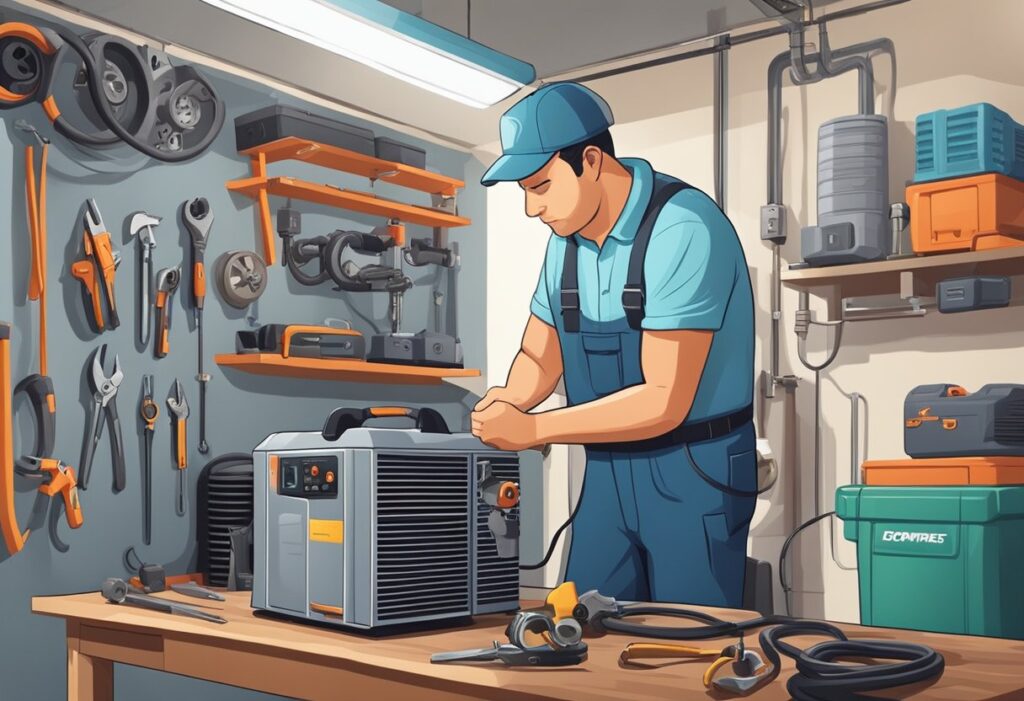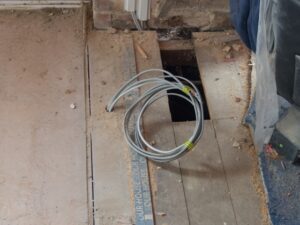Has your AC been acting up and you’re wondering how long it’ll take to get that compressor replaced?
We know how frustrating it can be when your home or office turns into a sauna.
The good news is that replacing an AC compressor typically takes anywhere from 4 to 8 hours for a standard unit. But if you’re dealing with a more complex system, it could stretch to 8-12 hours.
For larger commercial setups?
Well, you might be looking at a full 1 to 2 days of work.
Why does it take so long?
The complexity of your AC system and the condition of your current compressor are key factors. But here’s the thing—whether you’re tempted to do it yourself or call in the experts, understanding the time involved helps you plan accordingly.
While the DIY route might sound appealing, there’s real peace of mind in bringing in professionals like Excel Mechanical. With us, you get more than just a fast job—you get quality, efficiency, and results that make your home or business comfortable again. We take the hassle out of the equation, ensuring your system is running smoothly without any hidden costs or delays.
In this guide, you’ll learn:
- How long it typically takes to replace your AC compressor.
- The factors that can speed up or slow down the process.
- Why working with professionals might be the best decision for both your time and your wallet.
Let’s get started!
Understanding AC Compressor Replacement
AC compressors are crucial for cooling systems, converting refrigerant from gas to liquid, and maintaining pressure. Recognizing when they fail is important to avoid costly repairs.
Let’s start with the basics first!
Role of the AC Compressor
The AC compressor plays a vital role in an air conditioning system.
It compresses the refrigerant, turning it from a gas into a liquid. This process allows the refrigerant to flow through the system and cool your space effectively. The AC unit will not function properly without a working compressor, leaving your home or office uncomfortable during hot weather.
Additionally, the compressor helps maintain the correct pressure levels within the system. This ensures efficient cooling and reduces wear and tear on other components. A well-functioning compressor contributes to energy efficiency, lowering your utility bills.
Signs of a Failing AC Compressor
Identifying a failing AC compressor early can save you time and money.
- One common sign is warm air blowing from the vents, indicating the compressor can’t compress refrigerant effectively.
- Strange noises like rattling or hissing could also signal trouble, as they might suggest internal components are failing.
- Reduced airflow from vents may indicate a failing compressor, resulting in inefficient cooling.
- Furthermore, higher-than-normal energy bills can be a red flag. This increase happens as the system works harder to cool your space.
Factors Affecting Replacement Time
Replacing an AC compressor involves several considerations that influence the job’s time. Key factors include different vehicle types, the design of the AC system, and the availability of parts.
Type of Vehicle
The type of vehicle significantly impacts the time required to replace an AC compressor.
- Components are often more compact in smaller cars, which might make accessing the AC compressor more difficult and time-consuming.
- Large vehicles may provide easier access but have more extensive systems, which could mean more work.
It’s essential to understand your vehicle’s specific needs.
AC System Configuration
The configuration of the AC system itself also plays a role in how quickly a compressor can be replaced.
Systems with simpler layouts are generally faster, as technicians can access components without removing additional parts. Conversely, complex systems with multiple connections and components may require more time. Knowing your system’s design can help set realistic expectations.
Our team at Excel Mechanical is adept at handling various configurations, from straightforward setups to intricate systems, providing top-quality service tailored to your system’s design.
Availability of Replacement Parts
Having the necessary replacement parts on hand can significantly speed up the repair. If the parts are readily available, the entire process becomes much quicker.
However, delays can occur if specific components are hard to find or need special ordering. Checking part availability before starting the replacement can help plan the timing more accurately.
Working with a reliable HVAC service provider can ensure you have access to the necessary parts when needed.
Preparation for Replacement
Replacing an AC compressor involves several steps to ensure a smooth process.
Key aspects include gathering and organizing tools, following important safety guidelines, and diagnosing the AC system’s needs.
Tools and Equipment
Having the right tools is crucial when replacing an AC compressor.
Essential items include wrenches, screwdrivers, a manifold gauge set, and a vacuum pump. To safely capture the old refrigerant, you will also need refrigerant-specific tools, such as a recovery machine.
Consider having a new capacitor and filter drier on hand, as these may need replacement. Ensuring you have all necessary components ahead of time can prevent delays during installation.
Safety Precautions
Safety is a priority when dealing with AC systems.
Begin by turning off the power to prevent electrical hazards. Wear protective gear, such as gloves and safety glasses, to protect against sharp edges and refrigerant exposure.
Be aware of the risk of refrigerant burns, and always handle materials in a well-ventilated area. These precautions can help reduce injury risks and ensure the job is completed safely.
AC System Diagnosis
Before starting the replacement, diagnosing the AC system is crucial.
This involves checking for leaks, blockages, or electrical issues that could affect the new compressor. Use diagnostic tools to assess system pressure and ensure the compressor is the faulty component.
Understanding the problem helps you determine if additional parts, such as a capacitor or new filters, might be needed. It also ensures that installing the new compressor will restore the system to efficient operation.
Accurate diagnosis can help avoid recurring issues and ensure a successful installation.
The Replacement Process
Replacing an AC compressor involves several key steps that ensure your system runs smoothly again. These steps include removing the old compressor, installing a new one, and recharging the AC system. Each step requires careful attention to detail.
Removal of the Old Compressor
First, you need to disconnect the old compressor safely.
Begin by removing the compressor belt, which may require loosening other belts for access. Next, unplug the electrical connector linked to the compressor. It’s crucial to evacuate the refrigerant system professionally to avoid any hazards.
After removing the refrigerant, you can detach the mounting bolts from the compressor. Be cautious of any remaining connections. Once free, carefully lift the compressor out, taking care not to damage nearby parts.
Installation of the New Compressor
Position the new compressor in the same spot with the old compressor removed.
Attach it securely using the mounting bolts. Ensure that all components are correctly aligned to avoid operational issues. Next, reconnect the electrical connector and any detached hoses or lines.
Replace the compressor belt, adjusting tension as needed. This ensures the system operates efficiently. For the best outcome, consider expert installation from professionals. The skilled technicians focus on quality and value, ensuring the system meets your needs and budget.
Recharging the AC System
Once the new compressor is in place and connected, recharging the AC system is time.
Start by vacuuming the system to eliminate any moisture or air. This step is essential for preventing future issues and maintaining efficiency. Refill a vacuumed system with the correct amount of refrigerant. Caution is necessary to achieve the right balance to ensure optimal cooling performance.
After recharging, test the AC system to confirm that everything functions correctly. Adjust any settings as necessary. The goal is to have a well-functioning AC that effectively meets your cooling needs.
Post-Replacement Considerations
Once your AC compressor is replaced, it is key to ensure proper system function and longevity. These steps include conducting thorough system testing and adhering to preventive maintenance practices.
Here is what you need to know!
System Testing
After replacing the AC compressor, it’s crucial to test the entire system to ensure everything works correctly.
Start by checking the refrigerant levels and pressure. This helps confirm that the unit is correctly charged and running efficiently. Listen for unusual noises that might indicate problems, like loose parts or improper installation.
Next, examine the airflow and cooling efficiency. Using a thermometer, measure the temperature differential between the air entering and exiting the unit. Significant differences can point to a malfunction.
Finally, monitor the system for leaks, particularly around connections. This step prevents future breakdowns and costly repairs.
Preventive Maintenance Tips
Proper maintenance after a compressor replacement can extend the life of your AC system.
Clean or replace air filters regularly to maintain airflow and efficiency. Check the outdoor unit to ensure no obstructions, such as leaves or debris, could impact performance. Regular cleaning helps the unit breathe and function well.
Schedule bi-annual inspections with professionals. They ensure your system operates optimally and detect potential issues before they escalate. Consider a maintenance agreement to keep track of required service intervals. This ongoing care saves money and boosts the system’s lifespan.
Professional Service Vs. DIY
Choosing between doing it yourself or hiring a professional for AC compressor replacement can impact your cost, time, and the level of support you receive. Each has its benefits and potential drawbacks that need to be considered carefully.
Cost Implications
DIY projects may seem cheaper since you avoid labor costs. However, they can become costly if you make mistakes, need extra tools, or lack the skills to complete the work effectively.
Professional services might have higher upfront costs due to labor. However, these services often include additional benefits such as quality parts and expertise, which can be more cost-effective over time.
Professional repairs ensure that the job is done right the first time, reducing future expenses.
Time Commitment
Replacing an AC compressor on your own might seem manageable, but it can take longer than anticipated. It requires knowledge of electrical systems and specialized tools, and unforeseen hurdles may arise, extending the project.
Hiring experts can save you a lot of time. Professionals have experience with different brands and models, which enables them to troubleshoot quickly and complete the task within a reasonable timeframe, typically between four to eight hours.
Warranty and Support
When you replace an AC compressor yourself, there typically is no warranty.
If something goes wrong afterward, you might have to spend more to fix it. Also, DIY repairs often don’t include technical support or advice.
Professionals offer warranties on their work. Excel Mechanical, for instance, provides warranty services that can give you peace of mind and long-term reliability. If issues arise, support is available, which can prevent the need for further costly repairs. This backing ensures your system remains in top condition over time and maintains its efficiency.
Frequently Asked Questions
When your AC isn’t working quite right, it’s common to have a lot of questions. We’ve got you covered with some of the most frequently asked questions about AC compressors and what to do when they need replacing. Let’s break it down:
What are the signs that an AC compressor in a car needs replacing?
Signs of a failing car AC compressor include reduced cooling efficiency, strange noises, and leaks. Sudden changes in airflow or vents blowing warm air can also indicate potential problems with the compressor.
What factors can affect the duration of an AC compressor replacement in a vehicle?
The replacement duration can depend on the car model and the system’s complexity. Tech access and the condition of other AC components also play a role. Generally, replacing a car’s AC compressor takes several hours if done professionally.
Can I replace my home’s AC compressor myself, or should I hire a professional?
Replacing a home’s AC compressor can be complex and risky without proper HVAC systems and tools knowledge. Hiring a professional like Excel Mechanical ensures exceptional quality and safety. Professionals have the expertise to handle refrigerant and electrical components.
How much time should you allocate for replacing a home air conditioning unit?
Replacing an AC compressor in a home can take 4 to 8 hours for straightforward cases. Some installations may vary based on the system type and setup complexity. It’s best to consult with professionals for a more accurate estimate.
What are the typical costs of replacing an AC compressor in a residential setting?
Costs for replacing a home AC compressor reflect the component price, labor, and any additional parts needed. Prices vary widely based on the unit’s size, brand, and specific job requirements. Consulting with companies like Excel Mechanical can provide a tailored quote based on your home’s needs and budget.
Steps in Replacing a Refrigerator’s AC Compressor
Replacing a refrigerator’s AC compressor involves diagnosing the problem, safely removing the old compressor, and installing the new one. You also need to manage refrigerant recovery and recharge properly. This task requires specialized tools and knowledge, so professional service is advisable.




